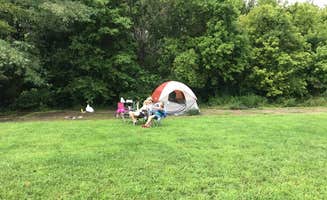Dispersed camping areas around Grandview, Missouri offer primitive outdoor experiences with varying seasonal availability. The region features conservation lands managed by Missouri and Kansas agencies. Average rainfall in the area is 42 inches annually, with summer highs typically reaching the low 90s, creating a humid camping environment during peak season from May through September.
What to do
Wildlife photography opportunities: At Leavenworth Kansas State Fishing Lake, the small 160-acre water body attracts various bird species and small mammals. "This is a small remote lake of about 160 acres water area. A county road takes you through the area and across the dam," notes John G., highlighting the accessible viewing areas.
Fishing at dawn: Many conservation areas have active fishing communities that start early. Kevin C. observed at Leavenworth Kansas State Fishing Lake: "Many slept in their cars and left at first light. I assume they went fishing at the lake."
Arrowhead hunting: Local history enthusiasts search for Native American artifacts in certain areas. At Montrose Missouri Conservation Area, camper Andi P. shares: "One of the locals stopped by my site to look for arrowheads. Apparently, she has found a lot in the area so that's a good activity if the kids are bored."
Wild berry picking: Seasonal foraging opportunities exist at several conservation areas. In Montrose Conservation Area, blackberries grow wild during fall months, adding a natural food gathering activity to camping experiences.
What campers like
Spacious, unmarked sites: The open grass areas allow campers to spread out without defined boundaries. Mark D. describes Montrose Missouri Conservation Area: "Large grass area available for tents or campers. No specific camp locations. No fire rings or picnic tables. Pit toilets are as expected."
Night sky visibility: Light pollution is minimal at most conservation sites, creating excellent stargazing opportunities. Sav at Montrose Conservation Area shares: "the stars were beautiful, the 'sites' were spacious and well spread out, and there is lots of shade."
Solitude even on weekends: Despite proximity to urban areas, most sites remain uncrowded. At Leavenworth Kansas State Fishing Lake, Kevin C. reports: "Camped here several days in late June. The were very few campers, even on the weekends."
Location convenience: Multiple sites offer easy highway access for travelers passing through. Logan M. appreciates Poague Campsite #5 for its "great secluded spot, right off the highway. Perfect for what I was looking for to car camp."
What you should know
Seven-day limits may apply: While Missouri conservation areas typically allow 14-day stays, nearby Kansas sites may have stricter limits. Rick M. warns about Leavenworth Kansas State Fishing Lake: "I'm starting to think that Kansas has a 7-day limit instead of a 14 because this is the second time that a Kansas park official came to the door and said we need to leave."
Confusing signage issues: Several conservation areas have unclear or poorly placed informational signs. Reagan G. at Leavenworth Kansas State Fishing Lake advises: "There is a brochure available online to help find the designated camping areas!"
Toilet maintenance varies significantly: Facility upkeep is inconsistent across conservation areas. Lee F. reports at Montrose Conservation Area: "The pit toilet was really gross, but there was toilet paper."
No trash disposal: Most free camping areas lack waste management facilities. Rick M. notes at Leavenworth Kansas State Fishing Lake: "No trash cans or water, but it's free."
Tips for camping with families
Bring complete water supplies: No potable water exists at most conservation areas. Plan for approximately one gallon per person per day, with additional water for cleaning and cooking needs.
Animal encounters can be educational: Wildlife sightings provide learning opportunities for children. At Crooked River Conservation Area, designated hunting and fishing areas create wildlife observation chances within a structured environment, as noted in Gary S.'s review mentioning "hunting, fishing and other outdoor activities inside the area."
Pack entertainment options: Limited recreational infrastructure means families should bring their own activities. Board games, field guides for plant identification, and star charts for night sky viewing can enhance the experience.
Prepare for bathroom situations: Pit toilets are the standard at most sites, and their condition can be unpredictable. Bring sanitizer, toilet paper, and possibly a portable toilet for young children unfamiliar with rustic facilities.
Tips from RVers
Site selection flexibility: The unmarked nature of these conservation areas allows RVers to choose level spots. At Montrose Conservation Area, camper T N. noted: "Mowed, TP stocked, plenty of firewood and room for dogs to run."
Smaller rigs recommended: Conservation area access roads and camping areas generally accommodate modest-sized RVs rather than large motorhomes. John G. cautions about Leavenworth Kansas State Fishing Lake: "Not suitable for larger vehicles."
Consider self-contained setups: With minimal facilities at most locations, RVs with onboard bathrooms provide significant comfort advantages. Most conservation areas lack hookups, dump stations, and potable water, requiring full tank management planning.
Lake views possible with strategic parking: Several conservation areas allow camping with water views when positioned correctly. Reagan G. at Leavenworth Kansas State Fishing Lake enjoyed "a beautiful view of the lake!"



